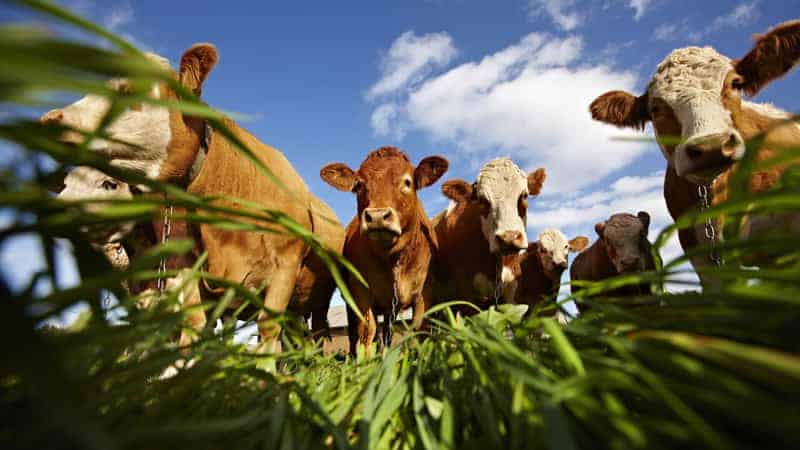Table of Contents
Animal Feeds and Feedings (Agriculture)
Animal nutrition has to do with animal feeds and how they are fed. This is all about feeding farm animals in the right way so that they grow well and have good body shape, and so that they are able to produce appropriately. It often shows how animals get nutrients from food and how their bodies use these nutrients.

What is Feed?
Livestock feeds are nutritive items like hay, straw, roughages, grasses, legumes and concentrates that are given to farm animals to keep them healthy and get them productive. For this to happen, the livestock farmer must make sure that the animals get the right amount and quality of feed.
On the other hand, nutrition is the use of scientific information to feed livestock on a daily basis. The goal of feeding animals is for them to turn the food they eat into valuable animal products. Many of the items that livestock eat are either not edible for people to eat or too much for their current dietary requirements.
Types Of Feeds
1. Energy Yielding Feeds
Carbohydrates are energy-giving organic molecules that are made up of hydrogen, oxygen, and carbon (CHO). With a 2:1 ratio of hydrogen to oxygen, they make up most of the food for animals. Extra carbohydrates can be retained by the liver and muscles, or they can be turned into fat and stored under the skin. Cereals (like millet, maize, and guinea corn), cassava tubers and peels, yam peels, banana and potato peels, wheat and rice bran, and other things are all good sources of carbohydrates for animal feed. They make up 60%–90% of what animals eat.
2. Protein-Yielding Feeds
Proteins are big, complex molecules made up of carbon, oxygen, nitrogen, hydrogen, and sometimes sulphur and phosphorus as well. Amino acids are the building blocks. Groundnut cake, palm kernel cake, cotton kernel meal, soybean meal, legume grasslands, etc. are all plant-based sources of protein for animals. Fish meal, blood meals, meat carcasses, and other animal parts can be used to feed cattle. Protein in animal feed helps animals grow and build their bodies, repair worn out tissues, replace broken tissues, get energy when they need it, produce enzymes, hormones, and blood, and improve their immune systems.
3. Fats and Oils (Lipids)
Lipids is the name for both fats and oils. At room temperature, fats are solid, while oils are liquid. They are groups of foods that give you energy. They mostly have carbon, hydrogen, and a tiny proportion of oxygen. They are a vital part of the brain, heart, lung, liver, egg, and milk of the animal. Where they get their energy from the oxidation process. Fat helps keep the body’s temperature steady because it doesn’t let heat pass through it well. Fats and oils protect important systems in the body. They store energy and vitamins that dissolve in fat. Oil seeds like groundnuts, palm kernel, coconut, soy bean, etc. are all good sources of fat.
4. Minerals
Mineral-rich feeds have the elements that are important to the body’s critical functions. Minerals are left behind as ash when a living thing is dried in an oven until its weight stays the same no matter what. In general, animals need up to 17 different nutrients. These are put into two groups: macro-nutrients and micro-nutrients. Animals need a lot of macronutrients, which are also called “major” nutrients. They are nitrogen, iron, phosphorus, calcium, magnesium, chlorine, potassium, sodium, and sulphur.
Trace elements are the elements that makeup micro-nutrients. They are needed in small amounts, but they are essential to the way animals’ bodies work. Iodine, cobalt, copper, zinc, selenium, and manganese are the six elements. They are needed in little amounts. Their jobs include making things like the teeth, bones, egg shells in birds, and other parts of the skeleton.
They help make fluids in the body, like blood, lymph, and so on. Bone meal, fish meal, blood meal, legumes and grasses used as fodder, cereal grains, oyster shell meal, salt licks, and mineral supplements made in a lab are all good sources.
5. Vitamin-Yielding Feeds
Vitamins are important organic substances that are needed for animals to grow and develop normally and for all living things to stay alive. There are two types: those that dissolve in water and those that dissolve in fat.
The fat-soluble vitamins are important for keeping the epithelial cells healthy, as well as for calcium and phosphorous metabolism, bone calcifying, normal production of eggs that will hatch, and the blood clothing during injuries. Green forages, yellow maize, colostrum, wheat offal, yeast, cereal grains, soy beans, rice bran, silage, legumes, leafy veggies, etc. are all good sources of vitamins for livestock.
6. Feed Supplements and Concentrates
Feed supplements are extra food given to animals to make up for deficient nutrients they aren’t getting enough of. They are usually high in protein and may also have some minerals and vitamins. They can be eaten alone or with other feeds.
Concentrate feeds are mixes of feeds that give animals their main nutritional needs, such as protein, sugars, fats and oils, minerals, and vitamins. They are either whole-grain feeds or mixes of additional feeds that are added to the basic feed. Bone meal, fish meal, groundnut and palm kernel cakes, cotton seed cake, and oyster shell meal are all kinds of nutrients and concentrates.
Animal Feeding Equipments
These are equipment that are used to feed animals on a farm. Most farm animals that only have one stomach are fed a mash made from grains like maize, guinea soybeans, millet, etc. The mash is made better by adding concentrates and supplements. Feeding and watering troughs, spades, shovels, grinders, buckets, and scooping bowels are just some of the tools used to feed animals. Some of the different types of feeding tools are:
1. Feeding Troughs
Feeding troughs are made of wood, metal, or plastic and are used to put food for the animals in the pen. For birds, they are long, thin, and rectangle. For other farm animals, they can be round, square, rectangular, or circular, with an open top and not too much depth. The type used would rely on how old, big, and what kind of animals they were. For pigs, concrete feed bunks are built, while feed buckets and a hay rack are used for sheep and goats. Hay racks are stands made to hold hay, straw, or other feedstuffs that are used to feed farm animals, especially ruminants.
2. Water/Drinking Troughs
These tools are used to hold water for farm animals in their pens or on the fields. By putting the drugs in the water, the feeding/watering trough can also be used to give drugs to animals. Bowls can be used to give farm animals water and other liquid. Most of them are made of plastic or metal, and they come in different sizes and designs.
3. Feeds processing tools
Tools for making food can be used to mix feed, sieve, grind, dry, or fry them. Some of these tools are spades, shovels, buckets, bowls for digging, grinders, sieves, deep-frying pots, and so on.



